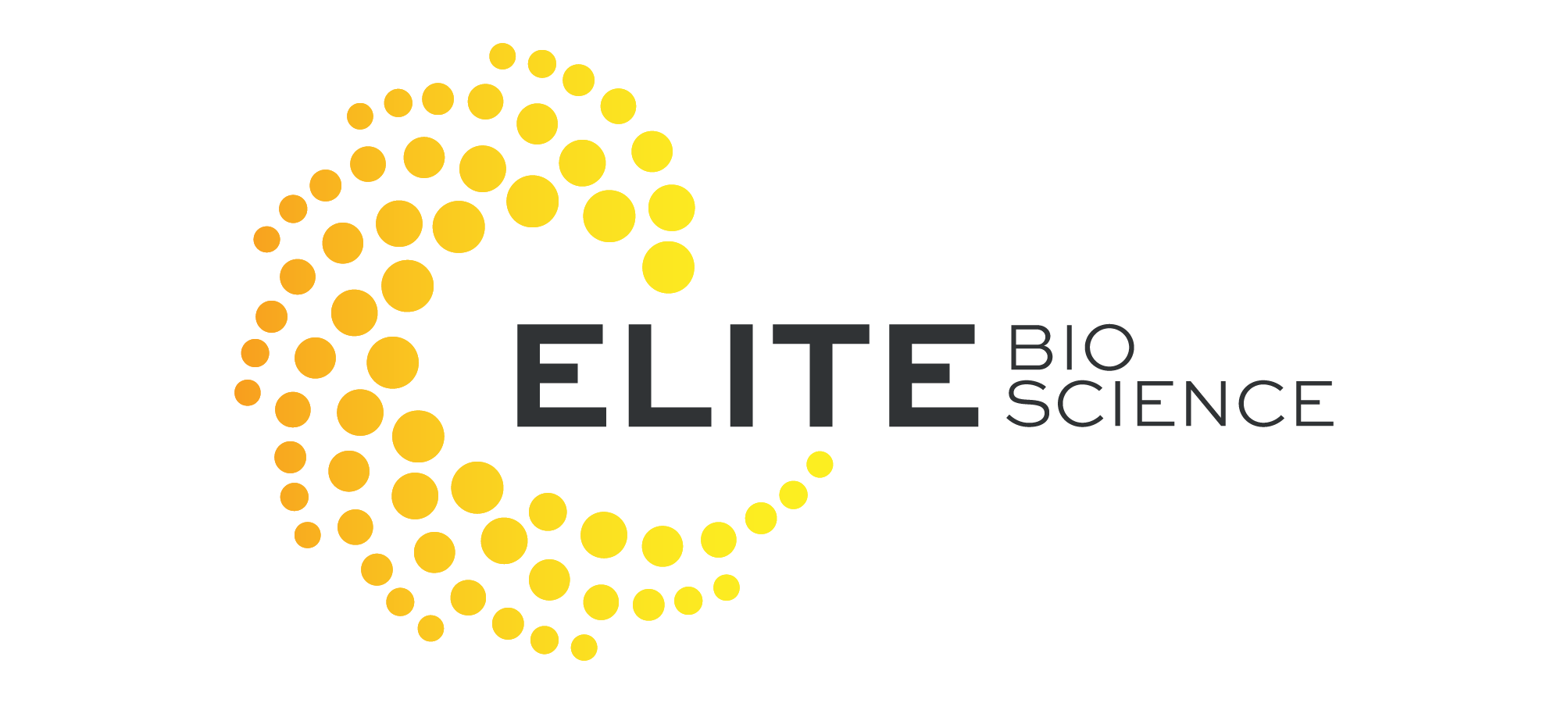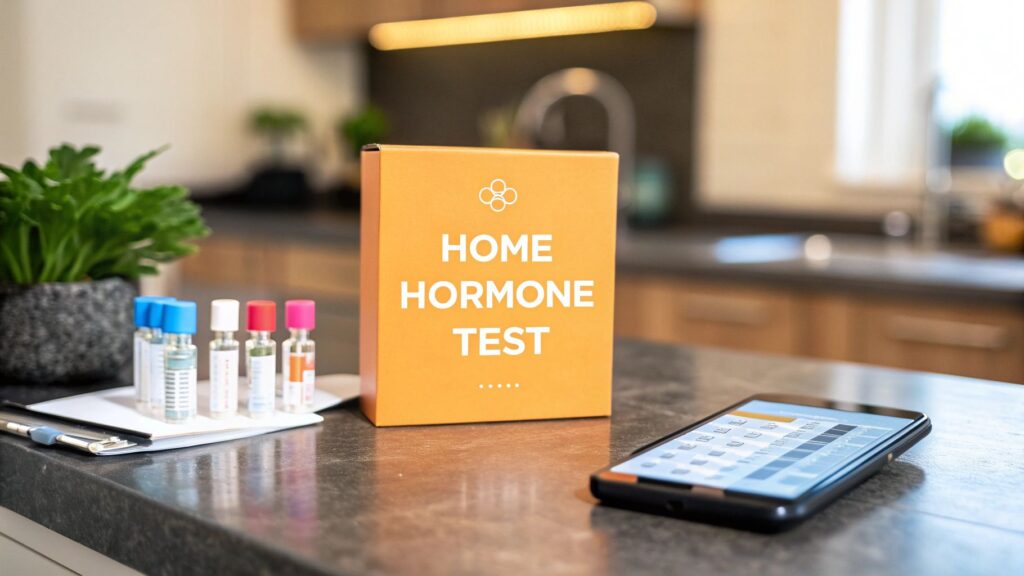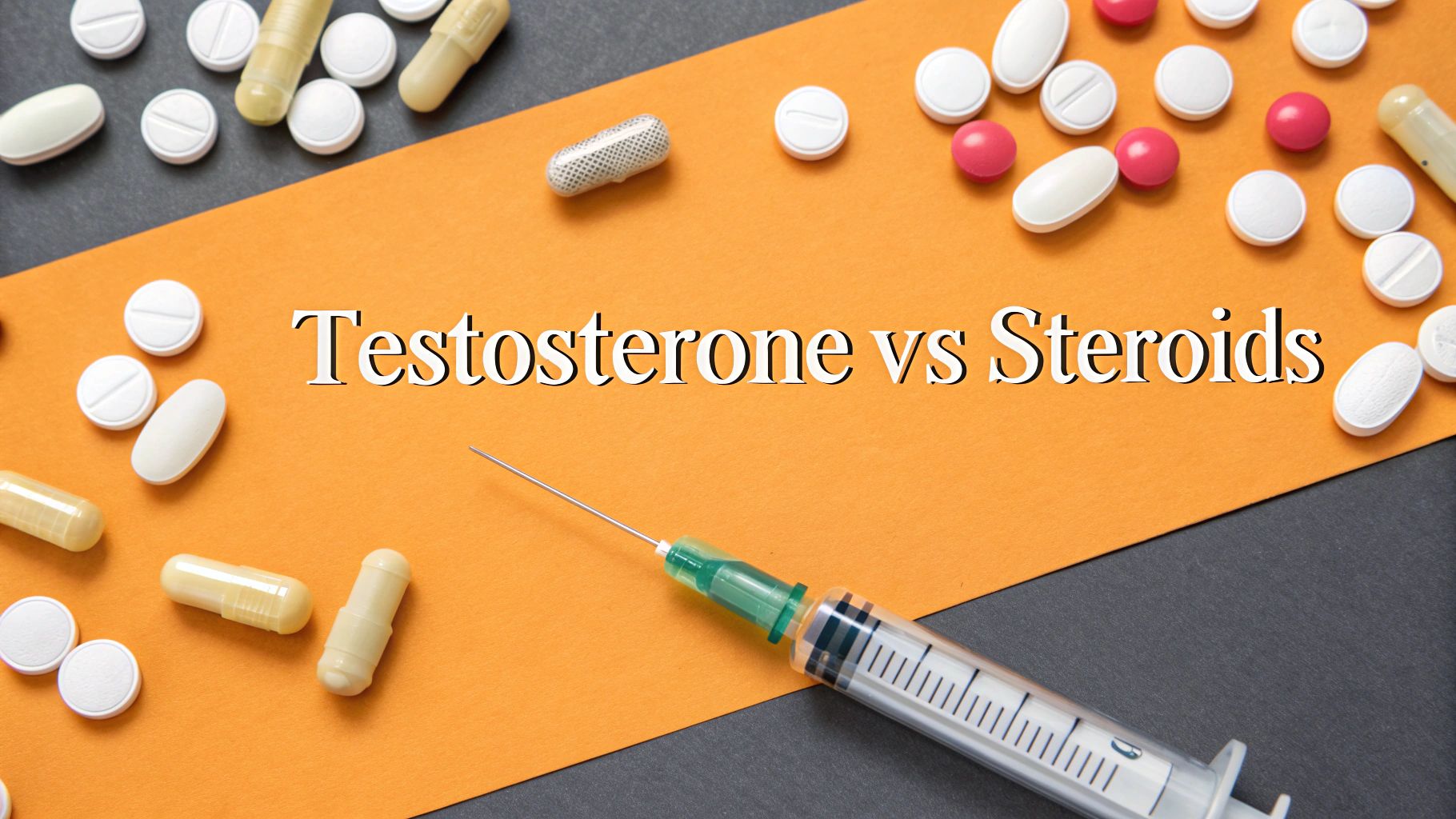Feeling "off" without knowing why is one of the most frustrating experiences. You know something in your body isn't quite right, but trying to pinpoint the cause can feel like guesswork. This is where a home hormone test kit comes in, offering a clear, data-driven starting point from the privacy of your own home.
These kits are simple, convenient tools designed to give you a snapshot of your internal health. They allow you to collect a small biological sample—usually saliva, urine, or a quick finger-prick blood spot—to measure the levels of specific hormones. It’s your first step toward turning vague symptoms into measurable information.
Your Personal Health Dashboard Awaits
Think of your hormones as the body's internal messengers, running a complex communication network that manages everything from your mood and energy levels to your metabolism and reproductive health. When these messages get scrambled or out of sync, it can throw your entire system off balance. A home hormone test acts like a personal health dashboard, giving you a peek under the hood at this intricate system.
Instead of just wondering about issues like persistent fatigue or unexplained weight changes, these kits empower you with concrete data. They demystify what’s happening inside your body and put you in a proactive position, equipped with the knowledge to take control of your health journey.
From Confusion to Clarity
The global market for at-home testing is exploding for a reason. Valued at around USD 7.85 billion, the industry is projected to climb to an estimated USD 13.67 billion by 2034. This trend isn't just about convenience; it reflects a massive shift toward people wanting to be more involved in managing their own health. You can see the full market breakdown in the detailed report from Fortune Business Insights.
For a quick reference, here are the essential things to know about these kits.
Key Facts About Home Hormone Testing
| Aspect | Description |
|---|---|
| What It Is | A kit for collecting a biological sample (saliva, blood, or urine) at home to measure hormone levels. |
| Primary Goal | Provides preliminary health data, not a final medical diagnosis. |
| Sample Collection | Non-invasive or minimally invasive methods like a finger prick, saliva swab, or urine sample. |
| Lab Analysis | Samples are sent to a certified lab for professional analysis. |
| Typical Turnaround | Results are usually available online within a few days to a week. |
| Main Benefit | Offers convenience, privacy, and actionable insights to guide conversations with a doctor. |
These kits bridge the gap between feeling unwell and seeking professional medical advice, giving you a solid foundation for that conversation.
This guide will walk you through everything you need to know about home hormone testing, so you can decide if it's the right tool for you. We’ll cover:
- How the sample collection and lab analysis process actually works.
- The key hormones these kits test for and what they can reveal about your health.
- How to choose the best kit for your specific wellness goals.
- What to do with your results and how to discuss them with a healthcare provider.
The primary goal of a home hormone test is not to provide a diagnosis but to supply you with actionable data. It transforms vague health concerns into a focused conversation you can have with a healthcare provider, armed with preliminary evidence.
By the time you finish this guide, you’ll have a clear understanding of how these kits work and the confidence to make more informed decisions about your health and vitality. Let’s get started.
How the Hormone Testing Process Works
Getting a handle on how a home hormone test kit actually works takes the mystery out of the whole experience. It's not some intimidating clinical procedure, but a simple, straightforward process you control from start to finish. Honestly, it’s far less complicated than you might think. The entire system is built for privacy and convenience, putting you in the driver's seat of your own health investigation.
Let's use an analogy. Imagine your body is a garden, but something is off—maybe the plants are wilting or just not growing right. A home hormone test is like sending a soil sample to a lab. You collect a small sample, send it to experts for analysis, and get back a detailed report explaining what nutrients are missing. Armed with that knowledge, you can give your garden exactly what it needs to flourish. The testing process follows that same logical path.
The Four Simple Steps of Home Hormone Testing
The whole thing boils down to four distinct stages, each designed to be as easy as possible. From clicking "order" to reading your results, every step is built around you.
Ordering Your Kit Online
Your journey starts by choosing and ordering the right test from a provider's website. You'll pick a kit based on your specific concerns, whether that’s general wellness, fertility, or checking a specific hormone like testosterone. It shows up discreetly at your door in a plain package with everything you need inside.Collecting Your Sample at Home
This is the "do-it-yourself" part, and it’s surprisingly easy. Kits use one of a few common collection methods, and they all come with clear, step-by-step instructions. These methods are minimally invasive and can be done in just a few minutes right in the comfort of your home.
This image shows just how simple the sample collection step is, a key part of the home testing journey.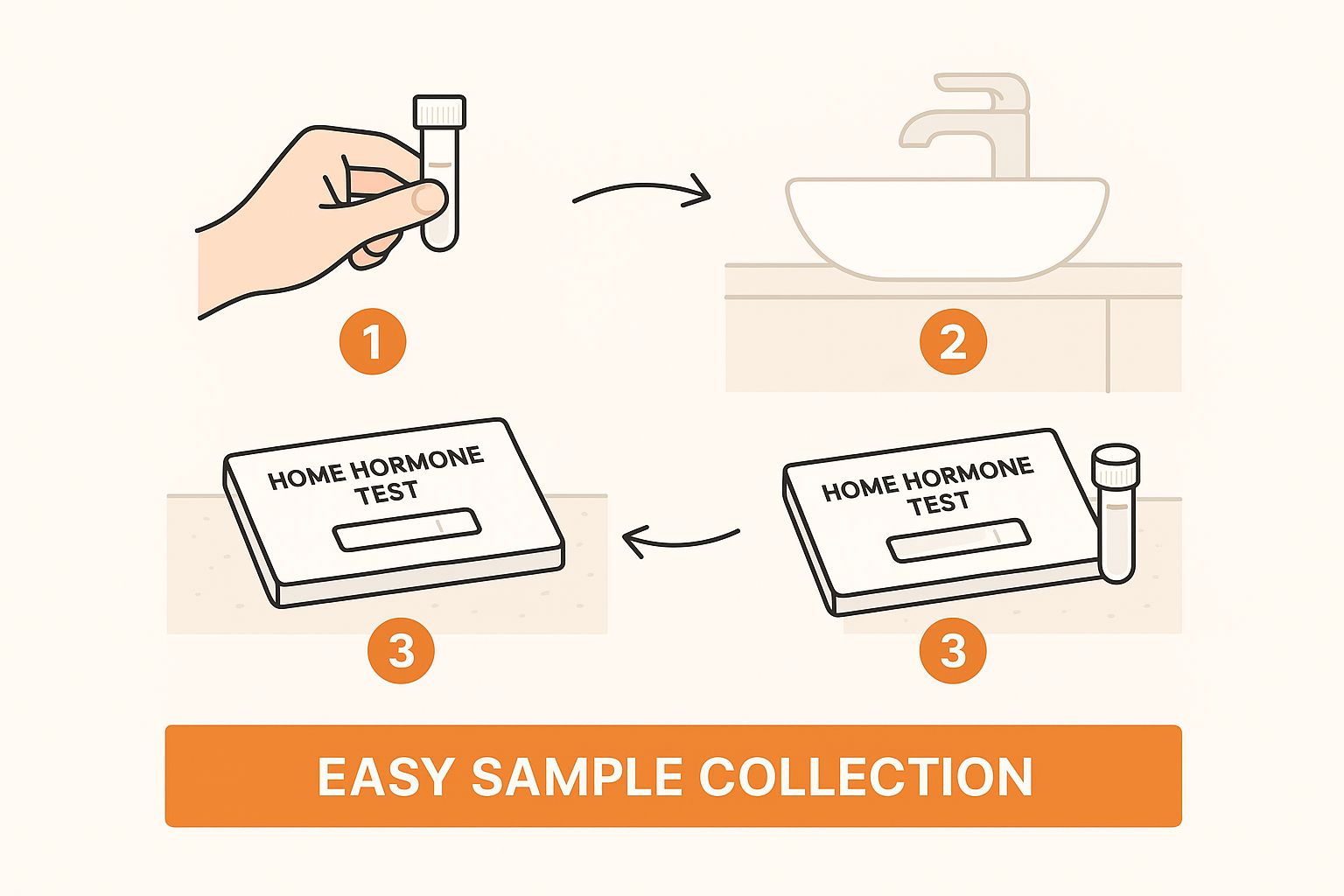
As you can see, the process is designed to be done easily in a familiar place like your own bathroom, removing any clinical anxiety.
From Your Home to the Laboratory
Once you’ve collected your sample, the rest is handled by professionals. This is where the real science happens, turning your tiny biological sample into powerful, actionable data.
Mailing Your Sample to the Lab
After collection, you simply package your sample in the pre-paid, bio-secure mailing envelope that came with your kit. Then, you drop it off with the designated courier. All the logistics are handled for you, ensuring your sample gets to the lab safely and quickly.Receiving Your Confidential Results
In about a week, the lab finishes its analysis. You’ll get an email letting you know your results are ready to view on a secure, private online portal. These reports are made to be user-friendly, often showing your hormone levels with helpful visuals and comparing them to established reference ranges for clarity.
The single most important element ensuring your home hormone test is reliable is the lab’s certification. Reputable companies will only partner with CLIA-certified laboratories.
This certification isn't just a suggestion; it's a non-negotiable standard of quality. CLIA stands for the Clinical Laboratory Improvement Amendments, which are federal regulations that hold labs to incredibly high standards for accuracy, reliability, and timeliness.
Essentially, it means the lab analyzing your sample follows the exact same quality benchmarks as the labs used by hospitals and your doctor’s office. It's the seal of approval that confirms your results are trustworthy and gives both you and your doctor confidence in the data.
What Your Hormone Levels Can Reveal
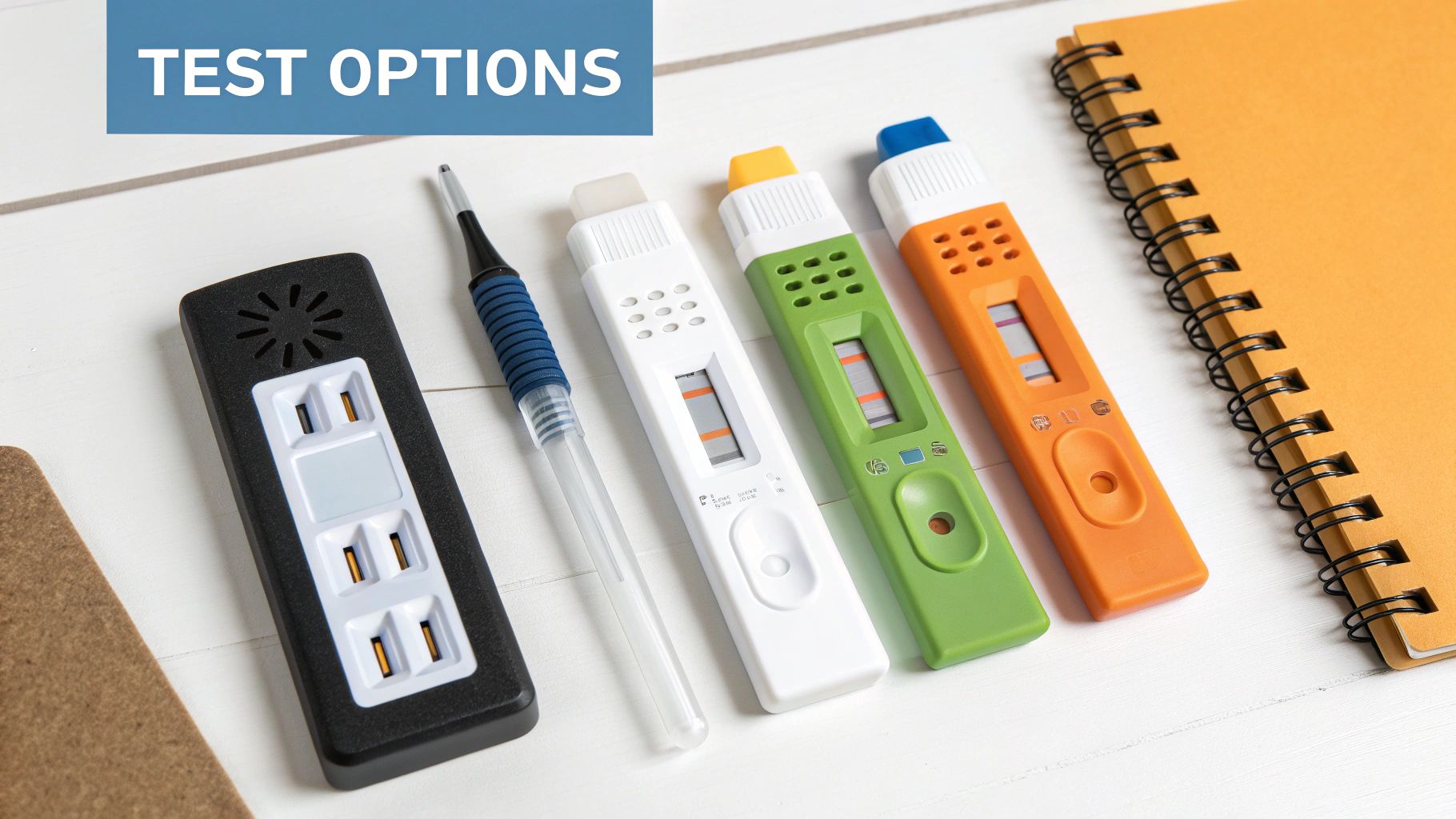
A home hormone test kit does more than spit out a bunch of numbers. It tells a story about what’s really going on inside your body. The results can finally connect the dots between how you feel and what’s happening on a biochemical level, turning those vague symptoms into clear, actionable insights.
Instead of just giving you a dry, scientific list of hormones, let’s look at what these tests can show you through the lens of real-life health goals. This way, you can see why certain hormones are tested together and what their combined story says about your well-being.
Insights for Fertility and Family Planning
For anyone planning to start or grow their family, timing and information are everything. Fertility-focused hormone tests give you a personalized roadmap of your menstrual cycle, helping you pinpoint your most fertile days and spot potential roadblocks early on.
This is a huge reason why at-home testing has exploded in popularity. These kits are a major driver of a booming at-home testing industry that's expected to rocket from USD 14.8 billion in 2022 to USD 31.15 billion by 2035. A massive part of that growth comes from women using ovulation and fertility kits to get a better handle on their chances of conceiving.
A good fertility panel will almost always include:
- Luteinizing Hormone (LH): Think of LH as the "green light" for ovulation. A dramatic surge in LH is the trigger that tells your ovary to release an egg. Tracking this spike is one of the most reliable ways to identify your peak fertile window.
- Follicle-Stimulating Hormone (FSH): Just like its name suggests, this hormone stimulates the growth of ovarian follicles—the tiny sacs that hold a developing egg. Elevated FSH levels early in your cycle can sometimes be a sign of a lower ovarian reserve.
- Estradiol (E2): As a key form of estrogen, estradiol’s job is to thicken the uterine lining, getting it ready for a potential pregnancy. It works hand-in-hand with LH and FSH to keep the whole cycle running smoothly.
- Progesterone: After you ovulate, progesterone levels shoot up to maintain that uterine lining and support a potential early pregnancy. If levels are low, it could be a clue as to why cycles are irregular or implantation isn't happening.
Unlocking Men's Health and Vitality
For men, hormonal balance is the engine that drives energy, mood, muscle mass, and sex drive. So, when guys start feeling run-down, less motivated, or notice a dip in their physical performance, testosterone is usually the first thing that comes to mind. A men's wellness home hormone test kit can cut through the guesswork and give a clear picture of what's happening.
Testosterone is the main male sex hormone, but its job goes way beyond the bedroom. It’s a powerhouse for building muscle, maintaining bone density, producing red blood cells, and even regulating cognitive function and mood.
A solid men's health test will typically measure:
- Total Testosterone: This is the big-picture number—the total amount of testosterone floating around in your bloodstream. Normal ranges for men are usually between 300-1,000 ng/dL.
- Free Testosterone: This is the good stuff. It measures the testosterone that's "unbound" and immediately available for your body to use. It’s often seen as a more accurate snapshot of how testosterone is actually impacting you.
- Sex Hormone-Binding Globulin (SHBG): This protein acts like a sponge, binding to testosterone and making it unusable. You can have normal total testosterone, but if your SHBG is high, your free testosterone will be low, leaving you with symptoms.
If your results come back on the low side, it gives you a concrete starting point for a talk with your doctor. It can also be the push you need to make some lifestyle changes, and you can learn more about the secrets to boosting testosterone levels with our science-based guide.
Understanding the Perimenopause Transition
Perimenopause, the multi-year journey leading up to menopause, can be a time of total confusion. Symptoms like irregular periods, hot flashes, mood swings, and sleep problems can feel random and overwhelming. A home hormone test can bring some much-needed clarity, confirming that these experiences are tied to your body’s shifting hormonal landscape.
The key hormones to watch during this phase are:
- Estradiol (E2): During perimenopause, estradiol levels start to fluctuate wildly and eventually trend downward. This hormonal rollercoaster is what causes many of the classic symptoms, from hot flashes to vaginal dryness.
- Follicle-Stimulating Hormone (FSH): As the ovaries become less responsive with age, the brain pumps out more FSH to try and kick them into gear. A consistently high FSH level is a key biological signal that menopause is on the horizon.
Testing these hormones can validate what you’re going through and help you and your doctor explore supportive therapies or lifestyle tweaks to make the transition a lot smoother. In the end, a home hormone test kit hands you back some control, translating your body’s signals into a language you can understand and act on.
How to Choose the Right Test Kit for You

With so many at-home health solutions on the market, picking the right home hormone test kit can feel overwhelming. But once you know what to look for, cutting through the noise to find the perfect fit becomes much easier. The goal is simple: find a test that directly addresses your personal health questions and gives you clear, reliable answers.
Think of it like choosing the right tool for a specific job. You wouldn't use a hammer to fix a leaky faucet. In the same way, you need to match the test kit to the specific "symptoms" or health goals you want to explore. A little bit of a structured approach can help you make a decision with confidence.
Start With Your Why
Before you even start browsing, the most important step is to get crystal clear on your personal health goals. What question, specifically, are you trying to answer? Are you trying to understand nagging fatigue, track your fertility, investigate signs of perimenopause, or keep an eye on your testosterone levels for performance?
Your answer to this question is the most critical filter you have. A vague goal like "I want to check my hormones" is just too broad to be useful. You need to get specific.
- Fertility Tracking: You’ll want a kit that measures key hormones like LH, FSH, and estradiol to help you pinpoint your fertile window.
- Men's Wellness: A test focusing on Total and Free Testosterone, along with SHBG, is going to deliver the most relevant insights.
- General Fatigue: A more comprehensive panel that includes cortisol (the stress hormone) alongside thyroid and sex hormones might be your best bet.
Pinpointing your "why" from the get-go ensures you invest in a test that measures the exact biomarkers you need, saving you from paying for data that isn't relevant to you.
Evaluate The Core Features of The Kit
Once you know what you want to measure, you can start comparing different kits. But it's not just about the specific hormones being tested; several other key factors determine the quality, reliability, and overall usefulness of the experience.
Choosing a test kit is about more than just the hormones it measures. It's about ensuring the entire process—from sample collection to understanding your results—is accurate, trustworthy, and user-friendly.
The best way to compare is to look at a few critical components that separate a high-quality kit from a less reliable one. With more men and women seeking direct ways to manage their hormonal health, understanding these features is key. Our guide on how to buy hormone and testosterone online easily and legally provides more context on how to access these solutions safely.
Here is a simple framework for evaluating your options.
Comparing Key Features of Hormone Test Kits
When you're trying to choose between different hormone test kits, it helps to break down what makes one a better choice than another. This table outlines the most important features to look for and explains why they are so critical to getting a reliable and useful result.
| Feature | What to Look For | Why It Matters |
|---|---|---|
| Lab Credentials | Explicit mention of CLIA-certified or similarly accredited labs. | This is the absolute gold standard. It confirms the lab meets strict federal regulations for accuracy and reliability—the same standards as a hospital lab. |
| Sample Collection | A method you are comfortable with (saliva, urine, or finger-prick blood). | If you're squeamish about blood, a saliva or urine test is a better fit. Your comfort and ease of use directly impact the quality of the sample you provide. |
| Results Reporting | Clear reports with visual aids, plain-English explanations, and established "normal" ranges. | Raw data is useless without context. The report should help you understand what your numbers mean for your health, age, and sex. |
| Post-Test Support | Options for a telehealth consultation or clear guidance on next steps. | Your results are just a starting point. Access to a healthcare professional to discuss your report adds immense value and helps you act on the information. |
By using this checklist, you can systematically vet any home hormone test kit you're considering. This approach ensures you’re not just buying a product, but investing in a tool that will deliver accurate, understandable, and truly actionable insights into your health.
Understanding Your Results and Next Steps
Getting that email with your home hormone test kit results can be a mix of nerves and excitement. Opening it up to a page of medical terms and numbers can feel a bit overwhelming, but what you’re holding is the first real step toward getting clarity on your health. The most important thing to remember is that this report isn’t a diagnosis. It’s powerful information meant to guide you.
Think of your results as a personalized weather report for your body. It tells you the current conditions—your specific hormone levels—and compares them to what’s considered normal, which is called a reference range. This range is what puts your numbers in context, showing you if a hormone is high, low, or right where it should be for someone your age and sex.
How to Read Your Hormone Report
Most companies design their reports to be easy to read, but knowing the layout helps. You’ll typically see your specific hormone level listed right next to the lab's established normal range. For example, your report might show your Total Testosterone is 250 ng/dL, with a reference range of 300-1,000 ng/dL. That’s a crystal-clear indicator that your level is on the low side.
It's tempting to fixate on one number that seems off, but it’s crucial to look at the whole picture. Hormones don’t work in isolation; they’re part of a delicate balancing act. A knowledgeable provider can help you connect the dots—like how high SHBG and low free testosterone might work together to cause the exact symptoms you're feeling.
This kind of direct-to-consumer testing has exploded in popularity, driven by a huge shift toward remote health options. More and more people are using a home hormone test kit for quick, private insights into their health. You can learn more about this trend by reading the full report on the at-home testing market.
Turning Your Results into Action
Your test results are the beginning of a conversation, not the end of it. Their real power is in letting you have a much more informed, productive discussion with a healthcare provider. Instead of just saying, "I feel tired all the time," you can now say, "I feel tired, and my test shows my testosterone is on the low end of the normal range."
A home hormone test transforms your subjective feelings into objective data. It gives you the evidence needed to move from wondering what's wrong to actively seeking a solution with professional guidance.
Many testing companies now offer a seamless next step through integrated telehealth services. A virtual consultation with a healthcare professional can help you make sense of your report and discuss potential next steps, from lifestyle tweaks to further medical evaluation. For those who might be considering treatment options, our guide on bioidentical hormone replacement therapy offers a deeper look into what’s available.
When you do talk to a provider, come prepared.
- Bring your report: Have your results ready to share, either digitally or printed out.
- List your symptoms: Connect the data points on the page to how you've actually been feeling.
- Ask smart questions: Don't be shy. Ask what the numbers mean together and what next steps they recommend.
Taking this proactive approach ensures you get the most out of your home hormone test kit, turning a page of data into a clear path forward for your health.
Your Questions Answered
When you're thinking about using a home hormone test kit, it's totally normal for questions to pop up. Let's walk through some of the most common ones. My goal here is to give you clear, straight-up answers so you can feel confident and informed about your next steps.
How Accurate Are Home Hormone Test Kits?
This is the big one, right? The short answer is: reputable home hormone test kits can be highly accurate, but there’s a catch.
The best companies use CLIA-certified labs—the same kind of high-standard laboratories your doctor's office or a hospital would use. That means the analysis of your sample is top-notch. The real variable here is you. The accuracy of the final result hinges almost entirely on how well you collect the sample.
Key Takeaway: Think of it like this: the lab provides the high-tech equipment, but you're the one operating it. If you don't follow the instructions to the letter—timing it right, avoiding contamination, and providing enough of a sample—the results can be skewed.
Because of this, it's best to see a home test as a powerful screening tool. It gives you an incredibly valuable starting point. If your results come back outside the normal range, the best move is always to share them with your healthcare provider. They can then decide if a follow-up test in a clinical setting is needed to confirm the findings.
When Is the Best Time to Take a Hormone Test?
The answer depends completely on which hormones you're checking. Hormone levels aren't static; they can swing wildly throughout the day or over a month. Following the kit’s timing instructions isn't just a suggestion—it's critical for getting a result that actually means something.
For example, timing is everything for certain tests:
- For Women Tracking Fertility: Hormones like Luteinizing Hormone (LH) and estradiol are all about timing. A test for these needs to be taken on very specific days of your menstrual cycle to be useful. Your kit will come with a clear calendar or guide to make sure you get it right.
- For Cortisol (Stress Hormone): Cortisol has a natural daily rhythm, spiking in the morning and tapering off by night. A cortisol test will usually ask you to collect several saliva samples at set times throughout the day to map out this entire curve.
- For General Wellness or Testosterone: For many general hormone panels, especially those looking at testosterone, the rule of thumb is to collect your sample first thing in the morning. This is when levels are typically at their peak and most stable, giving you the most reliable snapshot.
Does Insurance Cover Home Hormone Test Kits?
In most cases, no. Traditional health insurance plans generally do not cover the cost of these direct-to-consumer home tests. You should plan on this being an out-of-pocket expense.
There is a silver lining, though. You can often use funds from a Health Savings Account (HSA) or Flexible Spending Account (FSA) to pay for a home hormone test kit. Since these accounts are funded with pre-tax dollars, it can significantly lower the effective cost. Just be sure to double-check with your specific HSA or FSA administrator before you buy, as eligibility rules can differ.
Ready to move from guessing to knowing? Elite Bioscience offers a range of therapies guided by real data to help you optimize your health.
Explore our solutions and take control of your health journey today.
